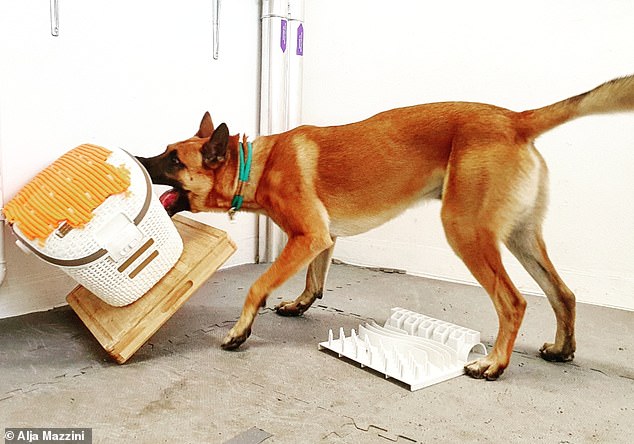Whether it’s a squeaky ball or a fluffy plushie, many dogs love their toys.
But a new study has warned that this love can tip over into an all-consuming addiction.
Scientists in Germany and Austria say that pet dogs can get addicted to toys – just like how humans can get hooked on gambling.
In their experiments, about a third of pet dogs showed signs of addiction, such as ignoring people, being disinterested in food and lacking self-control.
Dogs are ‘pawsitively hooked on toys’, claim the study authors at the University of Bern and the University of Veterinary Medicine Vienna.
Worryingly, it’s as yet unclear how such an addiction impacts a dog’s welfare.
‘Domestic dogs share many complex behavioural traits with us,’ the experts say in their new paper.
‘Our results highlight parallels between excessive toy motivation in dogs and human behavioural addictions.’

Some dogs show behaviours towards their toys that resemble behavioural addictions in humans, the study reveals. Pictured, a Malinois trying to get an inaccessible toy in a box while ignoring a food puzzle

Dogs are ‘the only non-human species so far that appears to develop addictive-like behaviours spontaneously,’ the experts report. Pictured, a bullterrier during tug-of-war play during the experiments
For the study, the team performed experiments with 105 dogs – 56 males and 49 females, ranging in age from 12 months to 10 years.
The most common breeds were Malinois (18 dogs), Border Collies (nine dogs), and Labrador Retrievers (nine dogs), but all dogs were described by their owners as motivated to play with toys.
In a 17ft by 11ft experimental room, the dogs were allowed to play with their favourite toy, with and without the owner and an experimenter present.
Objects included balls, tug-of-war ropes, stuffed ‘plush’ toys and ‘hybrid’ toys (a mixture of two different types).
Then, in various trials, experiments observed how the dogs would cope when access to the toy was removed.
In one trial, following a short period of play, the toy was put on a shelf so that the dog was unable to get it, followed by the owner attempting to engage with the dog.
In another, the toy was secured in a box with an orange lid, making it inaccessible to the dog, while a food puzzle was offered to them as a potential distraction.
Playtimes were filmed, and the researchers also surveyed the owners about their dogs’ everyday behaviours towards their toys.

In a 17ft by 11ft experimental room, the dogs were allowed to play with their favourite toy with their owner and an experimenter present

In one trial, following a short period of play, the toy was put on a shelf so that the dog was unable to get it. Pictured, a Malinois focusing on a green ball toy that is out of reach on a shelf
In all, 33 of the 105 dogs – about 31 per cent – showed behaviours ‘consistent with addictive-like tendencies’, the results showed.
Toy-addicted dogs were ‘excessively fixated on their toy’ and showed a lack of interest in alternatives, such as playing with their owner or even eating dry food.
Other behaviours also included making persistent efforts to access their toy when it was unavailable and being unable to calm down for 15 minutes after all toys were removed.
Researchers think some dogs show ‘behavioural addictions’, which are ‘compulsive engagement in rewarding activities despite adverse consequences in the long term’.
In humans, behavioural addictions include gambling, internet gaming, smartphone use, shopping and pornography – but in the absence of such human temptations for dogs, they are instead lured by toys, games and activities.
Humans, dogs and other mammals are hardwired to enjoy their favourite forms of play because it rewards our brains with pleasurable chemicals such as dopamine and opioids.
But ‘in some instances, what started as a fun activity can become compulsive and develop into a behavioural addiction’.
Behavioural addictions are less well-understood than substance addictions, the team say, although both involve symptoms such as craving, lack of self-control and social withdrawal.

In one trial, the toy was secured in a box with an orange lid, making it inaccessible to the dog, while a food puzzle was offered to them as a potential distraction. Pictured, a Malinois in the waiting position before giving the choice between available food (in the white food puzzle) or an inaccessible toy (in the box with orange top)
Before now, anecdotal evidence has suggested that some dogs display addictive-like behaviours towards toys, but this study, published in Scientific Reports, claims to be the first published scientific evaluation of such behaviours in dogs.
Dogs are ‘the only non-human species so far that appears to develop addictive-like behaviours spontaneously,’ they say.
Further research is now needed to determine the reasons for dogs excessively engaging with toys and whether this can negatively impact their welfare.
The researchers admit some limitations to their study; for example, specifically seeking highly play-motivated dogs means the sample is not a reflection of the general canine population.
Also, working dog breeds – historically bred specifically to complete practical tasks like finding and herding – were overrepresented in the sample.
‘Several publications state the importance of ‘obsessive’ play motivation for working dog success,’ they add.
This article was originally published by a www.dailymail.co.uk . Read the Original article here. .

